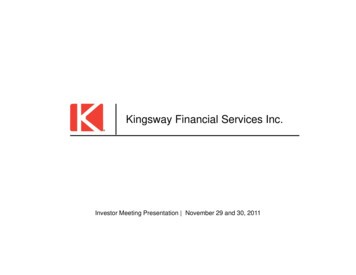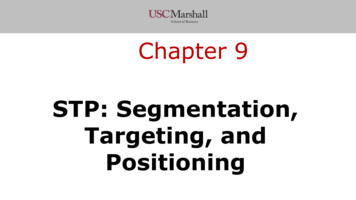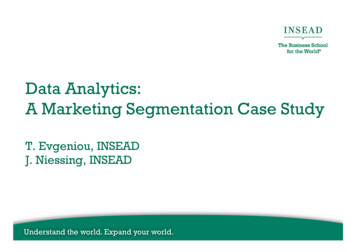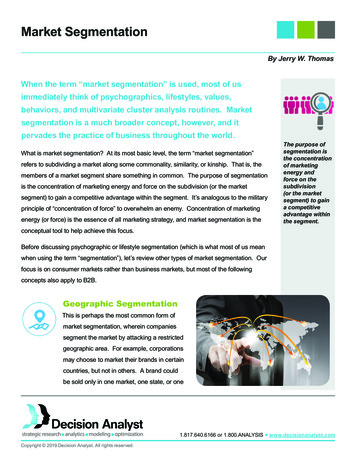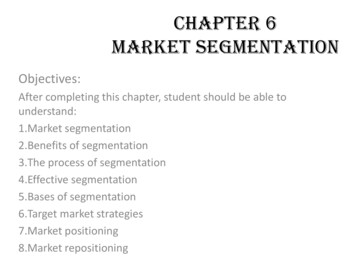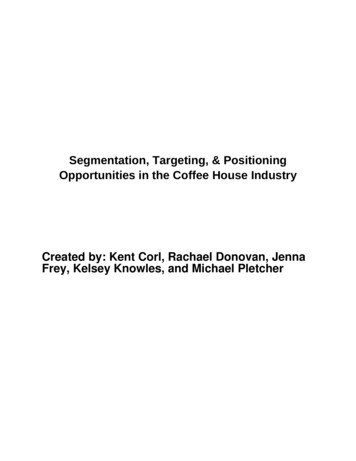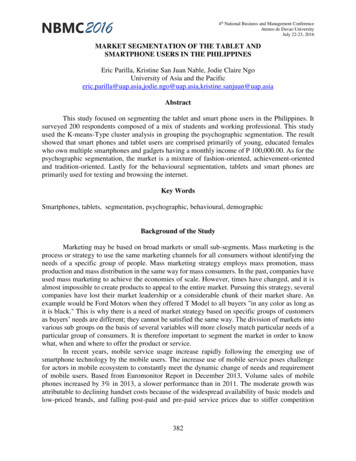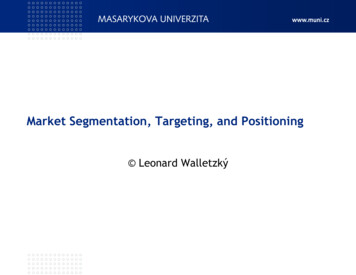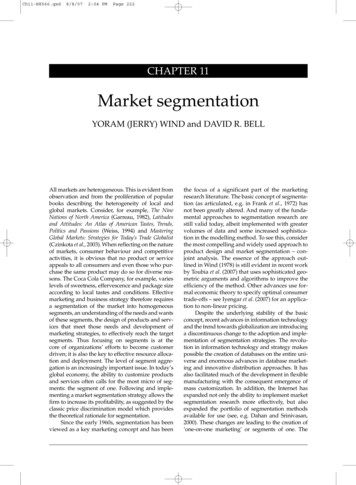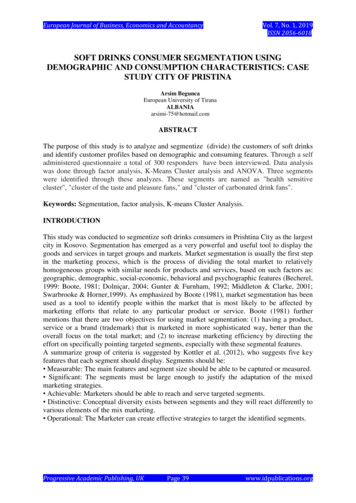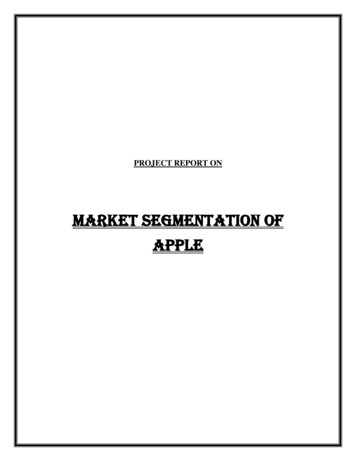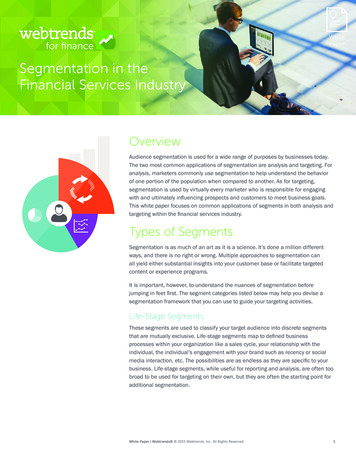
Transcription
WhitePaperSegmentation in theFinancial Services IndustryOverviewAudience segmentation is used for a wide range of purposes by businesses today.The two most common applications of segmentation are analysis and targeting. Foranalysis, marketers commonly use segmentation to help understand the behaviorof one portion of the population when compared to another. As for targeting,segmentation is used by virtually every marketer who is responsible for engagingwith and ultimately influencing prospects and customers to meet business goals.This white paper focuses on common applications of segments in both analysis andtargeting within the financial services industry.Types of SegmentsSegmentation is as much of an art as it is a science. It’s done a million differentways, and there is no right or wrong. Multiple approaches to segmentation canall yield either substantial insights into your customer base or facilitate targetedcontent or experience programs.It is important, however, to understand the nuances of segmentation beforejumping in feet first. The segment categories listed below may help you devise asegmentation framework that you can use to guide your targeting activities.Life-Stage SegmentsThese segments are used to classify your target audience into discrete segmentsthat are mutually exclusive. Life-stage segments map to defined businessprocesses within your organization like a sales cycle, your relationship with theindividual, the individual’s engagement with your brand such as recency or socialmedia interaction, etc. The possibilities are as endless as they are specific to yourbusiness. Life-stage segments, while useful for reporting and analysis, are often toobroad to be used for targeting on their own, but they are often the starting point foradditional segmentation.White Paper Webtrends 2015 Webtrends, Inc. All Rights Reserved1
Focused-Target SegmentsFocused-target segments are used for very specific targeting campaigns.Sometimes, these segments are based on a combination of life-stage segments,behaviors, demographics or transient attributes. People may move in or out of thesesegments, depending on changes in behaviors, demographics or attributes, sosegment populations are constantly changing.Discrete-Population SegmentsDiscrete-population segments are used to designate a specific group of people youwant to track and/or interact with over time. These segments are typically eventbased (people who opened a savings account in June, for example) and governedby a specific time frame. Therefore, this population does not change over time.No one new joins the segment and no one leaves it either. This type of segment issometimes referred to as a cohort.SegmentsLife StageFocused TargetDiscrete PopulationEvery person fits into a segmentPeople with specific behavior(s) /attribute(s)A specific set of individuals (oftentime based)Mutually exclusive; people only inone segmentOne person may belong to multiplesegmentsStatic – people do not move in orout of segmentsTrack progression from one segmentto the nextTrack who and total number ofpeople joining and leavingTrack behavior within a segmentover time and compareUse in combination with focusedtarget segmentsCan be used for specific campaignsand offersUsed for retention analysis andseasonal analysisWhite Paper Webtrends 2015 Webtrends, Inc. All Rights Reserved2
Common Life-Stage Segmentsfor Financial ServicesSales CycleBrowserMature organizations understand that you can have many different views of acustomer, depending on the lens. These same organizations track people inmultiple life-stage models, not just one. Why? Because life-stage models aretypically focused on individual facets of the relationship. Below are severalcommon life-stage models used in the financial services industry today.Sales CycleThe sales cycle life-stage model defines the journey from prospect to customerthrough the lens of the buying cycle.Researching ProspectPlanning ProspectDeciding ProspectBrowserVisited site in recent period but viewed no substantive content (financialproduct or service info)Researching prospectViewed information about a type of financial product or service in recent period(such as money market savings, 529s, Trading Account, IRA, etc.)Planning prospectViewed in-depth content around a life-stage topic or used a relevant tool (e.g.Mortgage Calculator, Retirement Planning, College Saving, etc.)Deciding prospectViewing specific financial service product variants (Funds, Account Types, etc.)Engaged ProspectActive CustomerEngaged prospectPost lead-generation, continued interaction as a prospect but has not yetconvertedActive customerCustomer who is using operational or transactional features of the website ona regular basis (e.g. online banking)Dormant customerCustomer who is not using operational or transactional features of the websiteon a regular basis (e.g. online banking)Dormant CustomerDigital Channels Interaction PreferenceThe digital channels interaction preference life-stage model defines customers’interactions with an organization’s online presence.Digital resistorsCustomers who have not interacted with your digital presence (web, mobile,social)Personal relationshipsCustomers who prefer personal relationships over digital interaction, so theyprefer direct communication channels (teller at a local branch, personal bankervia phone, etc.)White Paper Webtrends 2015 Webtrends, Inc. All Rights Reserved3
17%Increase in conversionsClient SuccessKimberly-Clark, a majorconsumer packaged goodsbrand and Webtrends client, hasdeveloped a highly successfulsegmentation strategy based onits customer life stages and howthey relate to its products. Thecompany groups its expectingand new parent visitors intosegments based on the age ofthe coming/new baby. Thosesegments include Baby on theWay, Newborn, Moving Babyand Toddler Time.As their customers’ babies grow,new products are targeted toparents that are best suited totheir child’s age. This is achievedthrough targeted content andcalls to action to sign-up for freesamples.This segmented targetingapproach resulted in a 17percent increase in conversions.Digital dabblersCustomers who use online sporadically but only for simple tasksDigital preferredCustomers who use digital channels for some specific tasks but not everythingCommitted to digitalCustomers who use digital channels for all tasks unless personal interaction isrequired to complete transactionLapsedCustomers who have interacted with your digital presence but no longer do soactivelyOnline EngagementThe online engagement life-stage model defines the levels of engagement that acustomer or prospect has with your website.NewcomerVisited for the first time in recent periodReceptiveViewed information about a financial product or service in recent periodAttractedReturned to site within one week or prior visitEngagedVisited three or more times or logged in during recent periodActiveFrequent visitor for more than four weeks, or logged in multiple times in the pastfour weeksHyperactiveMultiple log-ins or very frequent visitor (e.g. more than four weeks – more than twovisits per week)DormantNo activity for the past x monthsWhite Paper Webtrends 2015 Webtrends, Inc. All Rights Reserved4
Common Focused-Target Segmentsfor Financial ServicesAdditional Examplesof Focused-TargetSegments and TheirCommon UsesGeographicUse to create location-basedcampaigns or target people wholive within the region of geographiceligibilityProduct(s) ownedPerfect for discovering opportunitiesfor cross-sales and up-sales based onproduct mix and the development ofresulting targeted cross- and up-sellsegmentsAge groupCreate segments of customers basedon age range to help you to identifythe best financial products to promotein targeted campaigns aimed atprospects of a certain ageDeviceHelpful for creating targetedcampaigns that enhance the userexperience on mobile as well asprompting desktop web users whohave yet to utilize your mobile app toinstall it and drive usageFocused-target segments are used for very specific targeting campaigns. Typically,these segments are based on a combination of behaviors and demographics.People may move in or out of these segments, depending on changes in behaviorsor demographics, so the population of a segment is constantly changing.Target segments are often used in conjunction with a specific life-stage segment.As people move from one customer life-stage segment to another, there is anopportunity for targeting relative to that change. For example: active digital visitorswho moved to the dormant segment in the last month. Below are a few examplesof focused-target segments.New UserYour organization spends marketing dollars to get its customers to use itsonline tools or online banking capabilities, and help reduce costs associatedwith personal interactions. Once you’ve acquired new users, you should employtargeting to help ensure adoption. The first use of a new tool or service isabsolutely critical to establishing an ongoing pattern of adoption. Use on-sitetargeting to show instructions, help videos and ‘did you know’ content. Use emailtargeting to welcome the user and share tips or hints about the capabilities andfunctions available on the website, along with a link to the site.Lapsed UserIs it true that “all good things must come to an end”? Not if you can help it. Yourorganization should be targeting users who stop using online tools or onlinebanking capabilities. A lapse in use can often signal a shift to another financialinstitution. A 2014 survey indicates that more than one-third (37.7 percent) ofrespondents use more than one financial institution for their banking needs.Consistent competitive pressure reinforces the need to keep customers satisfiedand engaged as their loyalty wanes. There is a significant opportunity for targetinghere. Email targeting can serve as a gentle reminder that “we’re here whenyou need us” or perhaps to promote something new along the lines of, “try outour new service.” Use email targeting to drive log in, and then leverage on-sitetargeting to highlight those new features or services.New PlannerWhen prospects move from the researching segment to the planning segmentin the sales cycle life-stage model, there is an opportunity to interact with theprospect via targeting. At this stage, you most likely do not have their emailaddress, so on-site targeting would be the primary method for interaction. Youmight, for instance, promote the two most popular retirement planning tools youhave to someone who recently started looking at your retirement products.White Paper Webtrends 2015 Webtrends, Inc. All Rights Reserved5
Common Discrete-PopulationSegments for Financial ServicesClient SuccessA Webtrends client and majorinsurance provider utilizes acombination of focused-targetsegmentation strategies as wellas discrete-population segments.In one case, the provider neededto deliver special information tocustomers and eligible prospectswho were directly affected bya natural disaster. This segmentutilized a customer’s addressand the timing of the disasterto target these people withthe appropriate informationto ensure they were servedappropriately and understoodhow the insurance companycould help them to recover.Discrete-population segments are used to designate a specific group of peopleyou want to track and/or interact with over time. A type of discrete-populationsegmentation called cohorts compares the discrete-population to a controlpopulation to determine differences over time. What is unique about this segmenttype is that the definition places all applicable people into a single segment thatthey will never leave as a result of changes in behaviors or their stage in a lifecycle. Sometimes, these discrete populations are later targeted with life-stagerelated offers, but their primary use is in business intelligence and developing abetter understanding of the way in which a group of like customers are interactingwith your organization over time.In the financial services industry, these segments are typically used to followpeople who exhibited a high-value behavior in a specific time, such as opening asavings account in June or attending portfolio review in July. For instance, a cohortof people who opened checking accounts in June may receive an email with tipsfor using online banking in July and bill pay in August. Alternatively, a discretepopulation could be defined as people who purchased a mortgage from a singlebrokerage which would then be compared to other brokerages to understandwhich was best able to grow their customer accounts. In certain cases, discretepopulation segments can be used to identify candidates for cross- or up-sellopportunities. Finally, creating segments of customers who share a certain traitand watching the point in time where some choose independently to purchase anew financial product can be used to target the remaining members of the cohortwith similar products and services.Webtrends Can HelpWebtrends offers a variety of products and services to help you in your targetingand segmentation endeavors. Webtrends Segments makes it incredibly simple todiscover new segments or build segments you already know. Once defined, thesesegments can be automated for integration into action systems such as emailmarketing platforms and onsite targeting tools including Webtrends Optimize .Optimize provides organizations the ability to test and target relevant content inreal time on their websites and the ability to optimize the content over time.Additionally, Webtrends offers consulting services specifically for financial servicesand organizations needing additional expertise or lacking the bandwidth to createand execute on a targeting and segmentation strategy. Our team has worked withsome of the largest world-wide financial organizations to help them formulate astrategy, define a plan, and execute on an end-to-end segmentation and targeting
Your organization spends marketing dollars to get its customers to use its online tools or online banking capabilities, and help reduce costs associated with personal interactions. Once you’ve acquired new users, you should employ targeting to help ensure adoption. The first use of a new tool or service is
